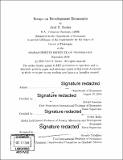Essays on development economics
Author(s)
Zucker, Ariel D. (Ariel Dama)
DownloadFull printable version (16.25Mb)
Other Contributors
Massachusetts Institute of Technology. Department of Economics.
Advisor
Abhijit Banerjee and Esther Duflo.
Terms of use
Metadata
Show full item recordAbstract
This thesis studies three questions in development economics. Chapter 1, co-authored with Shilpa Aggarwal and Rebecca Dizon-Ross, explores how the design of incentives should vary with the time preferences of agents. We formulate predictions for two incentive contract variations that should increase efficacy for myopic agents relative to patient ones: increasing the frequency of incentive payments, and making the contract "dynamically non-separable" by only rewarding compliance in a given period if the agent complies in a minimum number of other periods. We test the efficacy of these variations, and their interactions with time preferences, using a randomized evaluation of an incentives program for exercise among 3,200 diabetics in India. On average, providing incentives increases daily walking by 1,300 steps or roughly 13 minutes of brisk walking, and decreases the health risk factors for diabetes. Increasing the frequency of payment does not increase effectiveness, suggesting limited impatience over payments. However, making the payment function dynamically non-separable increases cost-effectiveness. Consistent with our theoretical predictions, agent impatience over walking appears to play a role in non-separability's efficacy: both heterogeneity analysis based on measured impatience and a calibrated model suggest that the non-separable contract works better for the impatient. Chapter 2 presents evidence that the standard electricity billing process contributes to inelastic demand. The paper assesses the elasticity of demand for electricity for customers using two metering and billing technologies. The first technology, postpaid metering, allows customers to use energy and subsequently bills them for the amount utilized. Many features of this system may reduce attentiveness to the marginal price of energy-consuming activities: electricity prices are buried in monthly bills; charges are aggregated over a lengthy billing period, making it difficult to match energy-consuming behaviors to kilowatt-hours used; and bills are delivered after consumption, potentially making cost less salient at the time of consumption. The second technology, prepaid metering, requires customers to purchase electricity prior to its use (similar to a prepaid phone plan). I find that customers who are charged under the second technology are approximately twice as price-elastic as those who are billed later. Chapter 3, co-authored with Nick Hagerty, presents an experimental protocol for a project that pays smallholder farmers in India to reduce their consumption of groundwater. This project will test the effectiveness of payments for voluntary conservation - a policy instrument that may be able to sidestep regulatory constraints common in developing countries. It will also measure the price response of demand for groundwater in irrigated agriculture, a key input to many possible reforms. Evidence from a pilot suggests that the program may have reduced groundwater pumping by a large amount, though confidence intervals are wide.
Description
Thesis: Ph. D., Massachusetts Institute of Technology, Department of Economics, 2018. Cataloged from PDF version of thesis. Includes bibliographical references (pages 209-219).
Date issued
2018Department
Massachusetts Institute of Technology. Department of EconomicsPublisher
Massachusetts Institute of Technology
Keywords
Economics.